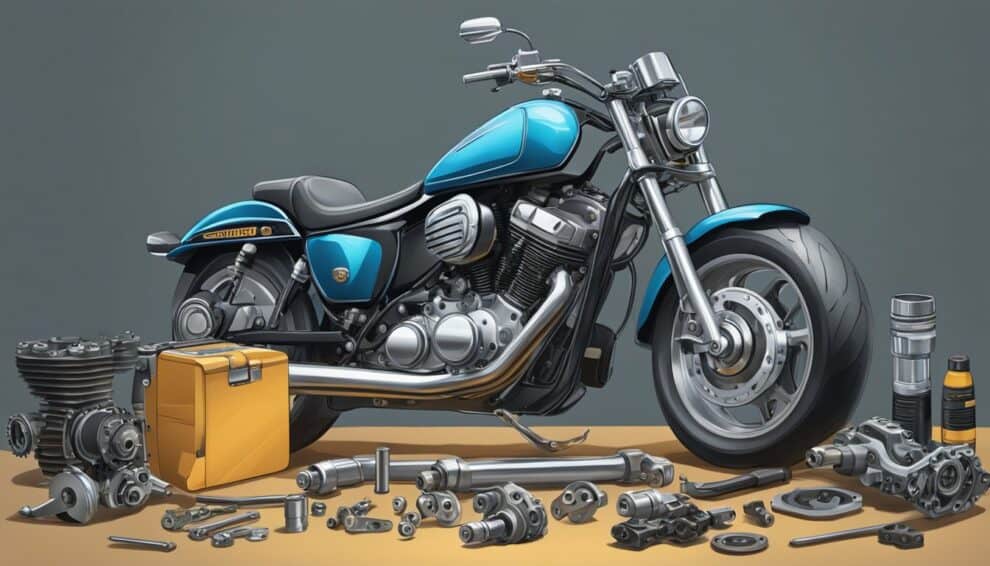Wondering if your motorcycle’s cam chain has seen better days? You’re not alone.
A stretched cam chain can lead to performance issues and, if left unchecked, significant engine damage.
Knowing the signs of wear and how to check the chain’s condition is crucial for any rider.
In this guide, you’ll learn the tell-tale symptoms of a stretched cam chain and the simple steps to diagnose it yourself.
Whether you’re a seasoned pro or new to the world of motorcycles, we’ve got you covered.
Keep your ride smooth and your engine healthy with these essential tips.
Signs of a Stretched Cam Chain
When you’re dealing with a motorcycle, understanding the health of your cam chain is crucial.
A stretched cam chain manifests in several telltale signs.
Here’s what you should be on the lookout for:
- Excessive Engine Noise: Unusual rattling or clanking sounds coming from the engine area, especially during startup or acceleration, can indicate a loose cam chain.
- Decreased Engine Performance: You might notice your motorcycle struggling with acceleration or showing a general decline in power.
This is often a symptom of the cam timing being off due to a stretched chain.
- Timing Issues: If the cam chain has stretched, it may throw off the engine’s timing.
This can result in poor idle, backfiring, or even engine failure if not addressed promptly.
Performing a direct inspection can often reveal the extent of a stretch in your cam chain.
By accessing the tensioner, you’ll be able to tell if it’s extended to its limits, which is a clear sign the chain has lengthened beyond acceptable tolerances.
Additionally, you can measure the chain’s wear by checking the chain deflection at the midpoint between the sprockets.
If the deflection measures beyond the manufacturer’s specifications, it’s time to consider a replacement.
Remember that early detection of a stretched cam chain is key to preventing more serious engine complications.
Regular inspections and listening to your bike can save you from hefty repair bills down the line.
If you’re unsure about the condition of your cam chain, it’s always best to consult with a professional mechanic who can provide a definitive diagnosis.
Tools You’ll Need
Before you can inspect your motorcycle’s cam chain, you’ll need to gather a few essential tools.
Proper preparation is key to accurately assessing the chain’s condition and ensuring your motorcycle continues to run smoothly.
Firstly, ensure you have a quality flashlight or work light to illuminate the dark areas around the engine where the cam chain resides.
Adequate lighting is crucial for identifying subtle signs of wear or stretch that can easily be overlooked.
Next, you’ll need a set of feeler gauges.
These precision tools will help you measure the gap between the chain and the gears it runs on.
If the gap is larger than the manufacturer’s specifications, it’s a clear indicator of stretching.
For a more direct measure, include a vernier caliper on your list.
This instrument allows you to measure the cam chain’s overall length and compare it to the standard length provided in your motorcycle’s service manual.
A service manual for your specific motorcycle model is indispensable.
This manual contains crucial details like the standard cam chain measurements and the official inspection procedure.
Always keep it at hand to ensure accuracy during your inspection.
Make sure you also have cleaning supplies such as rags, degreaser, and gloves.
These will help in clearing any grime or oil from the chain, which can obscure true wear levels.
Armed with these tools, you can properly inspect your motorcycle’s cam chain and address any issues before they escalate.
Remember, maintaining your bike requires attention to detail and the right tools for the job.
Step 1: Remove the Cam Chain Tensioner
Before you can inspect your motorcycle’s cam chain, you’ll need to remove the cam chain tensioner.
This is a critical step and must be done with caution to avoid damage to the engine.
First, ensure your bike is stable and that you’ve got easy access to the tensioner.
You’re going to need a few specific tools for this job:
- Socket set
- Screwdriver
- Torque wrench
Make sure you’ve got your service manual handy.
It will be your guide through the specifics, containing torque specs and the exact procedure for your motorcycle model.
Locate the tensioner; it’s usually on the side of the cylinder block.
Use your socket set to slowly and evenly loosen the bolts.
As you do this, take care not to drop any tools or parts into the engine—a magnetic tray can be handy here to keep small parts secure.
Once loosened, gently slide out the tensioner.
Keep an eye on any washers or gaskets; you’ll want to inspect and possibly replace these if they show any signs of wear.
With the tensioner removed, you’re set to move onto the next step — measuring the cam chain’s tension to determine if it has stretched.
Step 2: Inspect the Chain for Signs of Stretch
Once you’ve removed the cam chain tensioner, inspect the chain carefully for any signs of wear or stretch.
Stretching is a typical indicator that your chain has undergone significant stress and may be close to failing.
Look for these signs to assess the condition of your cam chain:
- Irregular wear patterns: You’re checking for any noticeable uneven wear on the chain’s rollers or links.
- Excessive slack: Using your feeler gauges, measure the slack in the chain.
Compare your measurements against the specifications in the service manual.
- Link elongation: Measure the length of a number of links with your vernier caliper.
If the length exceeds the service limit detailed in your manual, the chain is stretched.
Here’s a quick guide to help measure link elongation:
| Number of Links | Maximum Permissible Length |
|---|---|
| 10 Links | XX mm |
| 20 Links | XX mm |
XX corresponds to the values found in your service manual.
After assessing to this stage, you’ll likely have a clear indication of the chain’s condition.
If you find any signs that suggest it’s stretched, consider the impact on your motorcycle’s timing and performance.
Proper chain tension is critical for a smooth-running engine, and neglecting this component can lead to more significant problems down the road.
Remember, if there’s any doubt about the chain’s integrity, replacing it is the safer and more reliable option.
Step 3: Measure the Chain Length
Determining the actual length of your motorcycle’s cam chain is crucial for assessing its condition.
You’ll need a precise ruler or a caliper for accurate measurements.
Begin by locating a section of the chain that’s easy to access and measure.
It’s essential to measure the same number of links consistently to get an accurate comparison against the specifications in your service manual.
Place your measuring tool alongside the chain, carefully aligning it with the chain’s pins.
Count out a set number of links—the more, the better for accuracy—and note the length.
Here’s how you can interpret the measurements:
| Number of Links | Service Manual Specified Length | Measured Length | Chain Condition |
|---|---|---|---|
| 20 | 10 inches | 10+1/16 inches | Acceptable Wear |
| 20 | 10 inches | 10+1/8 inches | Consider Replacement |
| 20 | 10 inches | 10+1/4 inches | Replace Immediately |
A slight difference, such as a sixteenth of an inch over 20 links, may be within tolerable wear limits.
However, once the variance reaches or exceeds an eighth of an inch, it’s time to prepare for a chain replacement.
Also, be attentive to any tight or binding links; they could indicate damage or excessive wear even if the length seems within specifications.
Keep in mind that your motorcycle’s performance depends on the cam chain’s ability to maintain accurate valve timing.
Checking for wear isn’t just about chain length—it’s about ensuring your ride’s integrity and your safety on the road.
Step 4: Compare the Measurements
Once you’ve measured your motorcycle’s cam chain, it’s essential to compare these measurements against manufacturer specifications.
Your service manual is your best friend in this situation; it contains the recommended specs for your bike’s chain length.
Using the table provided previously, juxtapose your measured lengths against the specified lengths.
Should you notice differences between the measurements, assess the degree of variation.
While a slight deviation is often within the standard wear tolerance, significant discrepancies indicate a stretched chain that requires attention.
Remember, the magic number you’re looking for in variance is less than an eighth of an inch.
In addition to length, pay attention to the uniformity of the chain’s wear.
Chains often stretch unevenly, and this inconsistent stretch can lead to poor performance and potentially hazardous riding conditions.
If you find any sections of the chain that are unusually tight or binding, this could signify erratic wear.
| Specified Chain Length (inches) | Measured Length (inches) | Allowed Variance (inches) |
|---|---|---|
| X | X | ≤ 1/8 |
Keep these numbers in a safe place for future reference.
Periodic comparison to these benchmarks can be your earliest indicator of when it’s time to consider a chain replacement.
Remember, maintaining your motorcycle’s cam chain isn’t just about following these steps — it’s about ensuring the prolonged health and performance of your bike.
Step 5: Replace the Cam Chain
If your comparison reveals that the cam chain is stretched beyond the manufacturer’s specified tolerance, it’s time to consider replacement.
Tackling this task requires precise steps and an emphasis on attention to detail.
Order a new cam chain that corresponds with your bike’s model and year.
Ensure the replacement is from a reputable brand to guarantee longevity and optimal performance.
Before starting, gather all necessary tools, which typically include a cam chain rivet tool, chain breaker, and torque wrench.
Disconnect the battery and remove any components that obstruct access to the cam chain.
This usually involves the removal of the side cover, and sometimes the clutch or flywheel.
When installing the new cam chain, align it carefully with the sprockets, ensuring that the timing marks are in the proper position.
This step is critical for maintaining your bike’s engine timing.
Once you’ve got the chain in place, use the rivet tool to secure the master link.
It’s essential to rivet the chain correctly to avoid future failures.
After reassembly, double-check the engine timing and manually rotate the engine a few revolutions to make sure everything moves freely and the timing remains correct.
Before firing up the bike, confirm that every component you removed is back in place and properly torqued according to the service manual specifications.
Regular maintenance checks after replacement will help keep the cam chain in peak condition, ensuring that your ride remains smooth and reliable.
Remember that meticulous assembly and adherence to the service manual are your roadmaps to a successful cam chain replacement.
And, as with any maintenance task, if you’re uncertain about any step, seek advice from a professional mechanic to avoid potential damage to your motorcycle.
Frequently Asked Questions
What is a cam chain and why is it important?
A cam chain is a metal chain that synchronizes the rotation of the crankshaft with the camshaft(s) in an engine, ensuring the engine’s valves open and close at the proper times during each cylinder’s intake and exhaust strokes.
It’s vital for maintaining engine timing and performance.
How do I know if my cam chain needs replacing?
If your cam chain is making excessive noise, your motorcycle is experiencing performance issues, or you’ve measured the chain’s stretch and found it beyond the manufacturer’s specified tolerance, it may need to be replaced.
What are the steps to replace a cam chain?
To replace a cam chain, you’ll need to gather the correct tools, remove the old chain, align the new chain with the sprockets, and use a rivet tool to install the master link.
Maintaining correct engine timing is crucial, so double-check timing after reassembly.
How often should I check my cam chain for maintenance?
You should regularly check your cam chain as part of your motorcycle’s maintenance routine.
Consult your owner’s manual for specific intervals, but a common recommendation is to inspect it during each major service.
Can I replace my motorcycle’s cam chain myself?
Yes, if you have mechanical knowledge and the right tools, you can replace your motorcycle’s cam chain yourself.
However, if you’re unsure about any step in the process, it’s advised to seek the help of a professional mechanic to avoid potential damage to your motorcycle.
As an Amazon Associate we earn from qualifying purchases.










